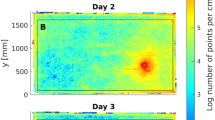Summary
Lasius pallitarsis ants were placed in situations where they encountered unfamiliar areas and had to choose between one of two directions for further exploration. Workers advancing onto new ground apparently leave behind some chemical signature to which later ants orient. This orientation occurred under two types of experimental conditions. First, ants show a significant tendency to follow each other as they advance out from their colony into unexplored areas. The same ants transferred into an entirely novel situation, in which there is no obvious “homeward” direction, show similar behavior. When ants are coming from familiar ground, following tends to increase as the number of ants passing the decision point increases. However, following decreases when ants are on entirely novel ground. The results are discussed in relation to models describing foraging responses.
Similar content being viewed by others
References
Aron, S., J. M. Pasteels and J.-L. Deneubourg, 1989. Trail-laying behaviour during exploratory recruitment in the Argentine ant,Iridomyrmex humilis (Mayr).Biol. Behav. 14:207–217.
Cammaerts, M.-C., E. D. Morgan and R. Tyler, 1977. Territorial marking in the antMyrmica rubra L. (Formicidae).Biol. Behav. 2:263–272.
Deneubourg, J.-L. and S. Goss, 1989. Collective patterns and decision-making.Ethol. Ecol. Evol. 1:295–311.
Hölldobler, B. and J. M. Palmer, 1989. Footprint glands inAmblyopone australis (Formicidae, Ponerinae).Psyche 96:111–121.
Möglich, M., U. Maschwitz and B. Hölldobler, 1974. Tandem calling: a new kind of signal in ant communication.Science 186:1046–1047.
Nonacs, P., 1990. Death in the distance: mortality risk as information for foraging ants.Behaviour 112:23–35.
Nonacs, P. and L. M. Dill., 1990. Mortality risk vs. food quality trade-offs in a common currency: ant patch preferences.Ecology 71:1886–1892.
Schmid-Hempel, P., 1987. Foraging characteristics of the desert antCataglyphis. In:From Individual to Collective Behavior in Social Insects. (J. M. Pasteels and J.-L. Deneubourg, Eds.), Birkhäuser Verlag, Basel, pp. 43–61.
Traniello, J. F. A., 1980. Colony specificity in the trail pheromone of an ant.Naturwissenschaften 67:360–361.
Traniello, J. F. A., 1989a. Chemical trail systems, orientation and territorial interactions in the antLasius neoniger.J. Insect Behav. 2:339–354.
Traniello, J. F. A., 1989b.Foraging strategies of ants.Ann. Rev. Entomol. 34:191–210.
Wehner, R., 1987. Spatial organization of foraging behavior in individually searching desert ants,Cataglyphis (Sahara desert) andOcymyrmex (Namib desert). In:From Individual to Collective Behavior in Social Insects. (J. M. Pasteels and J.-L. Deneubourg, Eds.), Birkhäuser Verlag, Basel, pp. 15–42.
Author information
Authors and Affiliations
Rights and permissions
About this article
Cite this article
Nonacs, P. Exploratory behavior ofLasius pallitarsis ants encountering novel areas. Ins. Soc 38, 345–349 (1991). https://doi.org/10.1007/BF01241870
Received:
Revised:
Accepted:
Issue Date:
DOI: https://doi.org/10.1007/BF01241870




